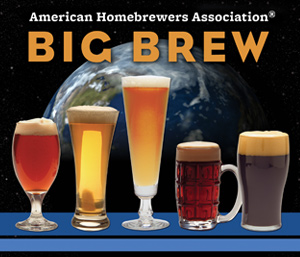Over the course of 2 days, John and I were able to try Kölsch made by 9 different breweries. Each brewery clearly had its on take on the style, but Kölsch definitely has some defining characteristics - and, like Altbier, is served in its own special glass: the 2cl thin-walled Kölner Stange. ("SHTONG-uh".)
Kölsch is a pretty narrowly-defined style, and the following stats come from Eric Warner's book on Kölsch. The
BJCP guidelines are even narrower in range. It's a filtered ale typically between 3.5-7 SRM (straw, light gold), has an OG of 1.045 - 1.050, 4.5-5.2% ABV, 16-34 IBUs, and is hopped using only noble hops. It's typically lagered for anywhere from 2-8 weeks (most Köln brewers appear to lager on the shorter end of that timeframe). It should have a soft pale malt flavor character with few fermentation flavor characteristics; it shouldn't be estery, fusely, or fruity. Lagering helps reduce diacetyl & acetaldehyde (green apple) as well.
Similar to Düsseldorf & Bamberg, the beers are often served from cask. The glasses are carried around by the servers in a tray called a Kölschkranz. The tray holds several beers at a time, and in at least a few places, the beers are filled halfway and set aside until someone orders them. The glasses are then filled to the brim and carried out. Unusual and seemingly inefficient, but fun to watch.
Another note about serving is that the person serving Kölsch (called a "Köbes") wears a long blue apron - and is typically male. While we did get our Kölsch poured by a female at one brewhaus (Reissdorf), she wasn't a Köbes. While it's not against the law to hire a female Köbes, it appears that it's just not done.
 |
| Kölschkranz at Gaffel |
 |
| Filling the Stanges. You can sort of see the cable mechanism in the background that Sion uses to bring the casks up from the cellar. |
Gaffel am Dom
This was the first Kölsch we had, and it ended up being one of my favorites. It had a lot of sulphur in the nose and was a bit vineous as well. I loved the contrast of the soft pils malt with the prominent (but not dominating) hop bitterness. The sulphur was also detectable in the flavor, but it was slight. I was surprised at this, as I'd have thought sulphur would have been undesirable in Kölsch but it was a rather common characteristic. Regarding the brewery itself, it's right on the cathedral square and the first recorded mention of it is dated 1302. Sadly, it was completely destroyed in WWII but (thankfully) rebuilt in 1955.
You can find Gaffel in some parts of the country; I tend to see it on the east coast. I definitely recommend ordering a glass if you ever see it on tap.
Früh
To contrast with Gaffel, Früh's Kölsch was a lot of sweet pils malt flavor, fruity esters, and had low hop bitterness. I got a lot of apple, pear, and white wine in both the aroma and flavor; it almost seemed like watered-down apple cider. The body was light, and the finish was very dry. While I didn't enjoy this Kölsch as much as Gaffel's, it'd be perfect on a hot summer day. I don't believe you can get this in the US.
Früh was founded in 1904 and made a less-bitter ale than the other breweries at the time. Remember that leading up to the early 20th century, the popular beer at the time (wiess) was bitter and unfiltered. It's suggested that Früh led the transition to the form of Kölsch we know today, though there isn't a lot of information I could find to back that up.
Brauhaus Sion
Similar in age to Gaffel, Sion was founded in 1318 but survived through the world wars intact. Their Kölsch had more of an earthy, herbal hop aroma than the others; the hop flavor was a bit different as well, being a bit peppery (but not spicy). Sion's Kölsch was low in sulphur and a bit "tangy" but low in acidity. Some Kölsch brewers use a little wheat in the grist, and Sion is one of them.
Peter's Brauhaus
Peter's is an interesting brewery, as they brew a pretty broad variety of beer. Though 95% of what they brew is Kölsch, they also make Altbier, pilsner, festbier, and a weizen. We didn't have any of those, though, and I'm not even sure they serve them at the brewhouse. We went to Peter's twice on our trip and had two entirely different experiences. The first night was subdued and laid back; the second time around, we were crammed into this little tasting room that seemed to keep getting more & more crowded. I remember crawling over a table just to get out.
I really enjoyed the beer (less so the 2nd time around, but only because I'd tried more Kölsch by that time and preferred others more). It had a mild floral hop aroma and had a bit more hop bitterness than some of the other Kölsches we had but still retained a solid malt/hop balance.
Malzmühle
In the 13th - 15th centuries, brewers made their own malt and would sell excess malt in the city center for regional breweries and homebrewers. The brewery located at that malt market is creatively named Malzmühle (malt mill), and we stopped in for a tipple.
Like the others, Malzmühle's Kölsch was a bit sulphury but also had a touch of green apple - likely from acetaldehyde. The pils malt sweetness was a bit dominant in this one and the hop bitterness was restrained. The finish wasn't quite as refreshing or dry as I'd hoped and I left this brewery unimpressed.
Päffgen
We were near a now-defunct brewery (zur Täsch) that serves as a beer bar, so we stopped in to try some Päffgen Kölsch (I'm getting a little tired of all the umlauts now). This place was a trip, as the decor inside all seemed to be from Gothic cathedrals.
Later on in our trip, we went to the actual Päffgen brewhaus and enjoyed it even more. The brewhaus is gigantic and full of different rooms. We went in late afternoon and the place was already packed
I really enjoyed Päffgen, though, and wish we could get it in the US. The lightly-sweet pale malt character shone through, but was met with a reasonable amount of hop bitterness and floral flavor & aroma. It was a perfect combination of tartness, malt sweetness, noble hop bitterness, aroma, & flavor, and a touch of sulphur in the nose. This quickly became one of my favorite beers of the trip...
Dom Kölsch
... and then we went to Dom.
Light sulphury aroma met by noble hops and faint pils malt breadiness. Flavor wasn't malty-sweet at all (finally!) and the finish was actually reasonably bitter and dry. It had a little bit of malt sweetness at the end, but really the balance was toward the bitterness of the hops used.
We ended up coming here twice and enjoyed the beer just as much both times. This became the most-liked Kölsch for both of us. And despite Dom being one of the largest Kölsch brewers in the country, their beer is, unfortunately, not available in the US.
Reissdorf
But one Kölsch that
is available in the US is Reissdorf! (Pronounced "RICE-dorf") When you think of Kölsch, this is possibly the brand that comes to mind. And while it wasn't our most favorite we had on our trip, it was still quite delicious, and fun to drink at the brewhaus.
Like Gaffel, the Reissdorf brewery was obliterated during WWII. It was rebuilt and brewing again by 1948, making several beers in addition to the Kölsch (such as pilsner & a dark lager).
I thought the aroma of Reissdorf's Kölsch was fantastic. Just a touch of sulphur, but in the forefront were the pils malt & floral hops... and unripe pear. I am not a fan of the fruitier Kölsches, and this was one of them. While the fruitiness & sweetness were not overwhelming in the least, they just led me to enjoy the Kölsch a bit less than those that had a sharper character to them (more hop aroma & bitterness, more sulphur).
That said, as I've been writing about Köln, I've been craving some Kölsch - and Reissdorf is available here in KC. You can get it on tap at
Flying Saucer & Grünauer - and if you ask nicely at
Grünauer's Wunderbar, they'll even serve it to you in a glass that's similar to a Stange. (I asked if they served Kölsch in a Stange, thinking they'd laugh at me, and instead I got my beer in a cylindrical glass! I love those guys!) Of course, you can get Schlafly's excellent Kölsch-style ale, but if you want a Kölsch from Köln, Reissdorf's is probably the most accessible.
Sünner
For our last dinner in Köln, we had mussels at a place called Bier Esel, which is apparently famous for them; they also serve Sünner Kölsch, which we hadn't yet tried. The Sünner brewery was destroyed in WWII, but like others, was rebuilt and brewing again. I found their Kölsch to be a bit too sweet, however, and didn't care too much for it. The hop aroma & bitterness were quite subdued, and instead the balance was toward pils malt & a moderate amount of apple-like fruitiness. Not my favorite.
The Verdict
I had a wonderful time trying all these variations on Kölsch. We tried beers from nine Kölsch breweries, a little more than a third of the number of breweries allowed by the Konvention to call their beer Kölsch. And here is how we ranked them. Both John and I came up with our individual lists and as it turns out (perhaps not surprisingly), that we ranked them in the same hierarchy.
- Dom
- Gaffel
- Päffgen
- Peter's
- Sion
- Reissdorf
- Sünner
- Malzmühle
- Früh
Next up - the food of Köln.














